
 Athens - New York > article by Koskina
Athens - New York > article by Koskina
Elli Souyoultzoglou-Seraidari, or ‘Nelly’, as she is usually referred to —she herself uses the possessive form of her name in English, ‘Nelly’s, as her artistic signature— was born about a century ago at Aidini, Asia Minor.
At the age of six, she began Greek school. In July 1919, she lived through the catastrophe of the devastation, by Turkish troops, of the Greek town of Aidini. Her family managed to escape, and settled in Smyrna, but Nelly departed the following year for Dresden in Germany in order to study music and painting. It was there, in September 1922, that news reached her of the holocaust of Smyrna and the massacre of the Greeks of Asia Minor by the Turks. Her family was one of those which fled and moved to Greece —which Nelly visited for the first time in 1924, when she left Germany having completed her studies in photography and decided to settle in Athens.
Although she had set out to study painting, Nelly finally turned towards photography because, in new and difficult circumstances, she needed a speedier way to secure a profession and an income. This explains her initial attraction to Φldruck and Bromoil, techniques long known to photographers which enabled her to see photographs not only as a means for conveying a scene clearly and realistically but also as a method for exploring and expressing her relationship with the world which surrounded her. These same techniques also allowed her to give her subjects a pictorial dimension which went some way towards satisfying her artistic concerns.
Virtually throughout her career, Nelly worked thematically, in photographic units, sometimes on her own initiative and sometimes to commissions, usually from the Ministry of Culture. The classification of her photographs under thematic headings cannot help but be slightly arbitrary, since she really only gave titles to three to four of the units. However, the task of studying her work and filing her material leads almost inevitably to a thematic classification, which in the context of a text to accompany an exhibition is of necessity a form of shorthand.
Nelly opened her first studio in Greece in 1925.  Fully equipped with the last word in the camera technology of the age and now a professional photographer, she
began to wander through the city of Athens, and especially the working-class districts around the Acropolis —such as Plaka— taking photographs as she went. These first photographs, striking for their humble subjects, and a few photographs she took of the impoverished refugees living in huts after their expulsion from Asia Minor by the Turks,
are an important part of Nelly’s photographic oeuvre. In them, she made extensive use of the Bromoil technique.
Fully equipped with the last word in the camera technology of the age and now a professional photographer, she
began to wander through the city of Athens, and especially the working-class districts around the Acropolis —such as Plaka— taking photographs as she went. These first photographs, striking for their humble subjects, and a few photographs she took of the impoverished refugees living in huts after their expulsion from Asia Minor by the Turks,
are an important part of Nelly’s photographic oeuvre. In them, she made extensive use of the Bromoil technique.
Nelly’s camera caught in its full measure the unhappiness and human misery reflected in the faces and bodies of the refugees. As a refugee herself, she was
particularly sensitive to their sufferings and strove to convey all “their tragic wretchedness and the heart-breaking depths to which they had sunk”, as she herself put it.
In order to photograph the old houses and everyday life of parts of Athens many of which are now long demolished, Nelly used the pictorialist techniques she
had been taught in Germany. Her ultimate aim was to create images which would have all the uniqueness of art works. Dimitrios Kambouroglou, a most important Greek historian, saw the photographs and proposed to Nelly that they should work together on a historic and photographic album on Old Athens. In the end, it was not until 1997 —thanks to the Benaki Museum— that the album was eventually published.
“I protest in the name of the Gods of Olympus, who, as everybody knows, not only walked nude, male and female alike, but were worshipped in their temples completely naked”.
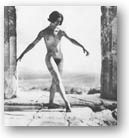
With these words, written in May 1929, Pavlos Nirvanas took up the cudgels, in the columns of Eleftheron Vima, in support of the young photographer Nelly. In 1927, Nelly had dared to photograph Mona Paeva —prima ballerina of the Opera Comique— nude in the Parthenon, “thus desecrating the Sacred Rock”.
Even then, the photographing of a naked body was neither unusual and provocative. In photographing nudes, Nelly was doing nothing original.. But no one had
dared to photograph nudes in a taboo location, in a space symbolic of a whole civilisation. That was why her photographs were greeted by such an outcry, especially from the conservative sections of society. Apart from the refinement of their photographic technique, Nelly’s nudes stand out for their marked inwardness, which accentuates the sculpturesque forms, the plasticity of the light, and all the spirituality of the ancient Classical ideal as expressed in the naked body. Nelly had no wish to create a scandal or simply sell photographs in the hope of making an easy profit and gaining publicity; she photographed the dancer for herself, believing that in the dancer and the temple she had
rediscovered an old, forgotten relationship based on equilibrium, moderation and the harmonious coexistence of the architectural scale and the human figure. Nor were the photographs of Mona Paeva the first nudes Nelly had photographed. When she was still a student in Dresden, in the early Twenties, her teacher Franz Fiedler had mediated to enable her to photograph the dancers of the famous Mary Wiegman School —and to do so not
only in the studio, as was the usual practice among the photographers of the time, but also in the open air. She travelled with them to ‘Saxon Switzerland’, because there she could place them in nature and to juxtapose its beauty against that of the human body. In the suppleness of the naked body and its morphological association with the plasticity of the natural environment we can see an early interest —one which, as it happened, Nelly never followed up— in a comparative morphological exploration in the direction in the British sculptor Henry Moore conducted subsequent, and more profound, investigations.
The structure and the commanding presence of the ancient monuments and the scope for animating them by the vigour and freshness of the sensitive 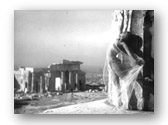 female body did not, however, cease to occupy her thoughts. Later, she photographed the Spanish dancer Aurea in the Theatre of Dionysus, and the French dancer Daljell and Nikolska from Hungary in the Parthenon. The series of photographs of Nikolska, clad sensually in gossamer veils “so as to prevent any misunderstandings from arising”, are not only among the best photographs of this period anywhere in the world, but also contributed to the formation of a sense of aesthetics in Greece where the representation of the female body was concerned.. The female body, as Nelly depicted it, stripped of all hint of sexual provocation, nonetheless maintains an eroticism which intertwines with and complements an aesthetic ideal while at the same time referring to idealistic representations of the poetics inherent in Greek mythology.
female body did not, however, cease to occupy her thoughts. Later, she photographed the Spanish dancer Aurea in the Theatre of Dionysus, and the French dancer Daljell and Nikolska from Hungary in the Parthenon. The series of photographs of Nikolska, clad sensually in gossamer veils “so as to prevent any misunderstandings from arising”, are not only among the best photographs of this period anywhere in the world, but also contributed to the formation of a sense of aesthetics in Greece where the representation of the female body was concerned.. The female body, as Nelly depicted it, stripped of all hint of sexual provocation, nonetheless maintains an eroticism which intertwines with and complements an aesthetic ideal while at the same time referring to idealistic representations of the poetics inherent in Greek mythology.
‘Nudes on the Acropolis’ brought about a change in beliefs about the way the naked body should be shown and approached. Almost in parallel, some of the
leading Greek painters of the Thirties included depictions of nudes in natural settings among their works.
After the uproar over the photographs of Mona Paeva, Nelly never again photographed nudes in exterior settings. But Isadora Duncan’s long-standing dream of dancing nude among the ancient columns, Eva Palmer-Sikelianos’ vision of resurrecting the Delphi  Festivals, the Delphic Utterance of her husband, the poet Angelos Sikelianos, and, beyond doubt, the consistency between Nelly’s own education and the German aesthetics which supplemented it, were the factors that led her to Delphi in 1927 and 1930. In the latter year, indeed, she was selected as exclusive photographer to the
second Delphi Festivals. There, the female and male body, nude or clothed, revived ancient sculpture and painting in their natural setting. The scenes depicted on vases and reliefs were born again in Nelly’s photographs of the dances performed during the tragedies of Aeschylus, of the Games, of the ‘pyrrichios’ war dance, of the tragic figure of
Prometheus, and of the dramatic quality of ancient masks when combined with the magical, mysterious landscape. Nelly succeeded in transforming the chorus of the Greek drama into a living frieze; here she was influenced by the example of Eva Sikelianos, who drew on figures from ancient Greek amphorae in designing the sets and costumes for the performances. Nelly photographed Eva herself and the girls of the chorus in classical poses from ancient Greek reliefs and vases. These photographs were later published as postcards, making the Delphi Festivals famous all over the world.
Festivals, the Delphic Utterance of her husband, the poet Angelos Sikelianos, and, beyond doubt, the consistency between Nelly’s own education and the German aesthetics which supplemented it, were the factors that led her to Delphi in 1927 and 1930. In the latter year, indeed, she was selected as exclusive photographer to the
second Delphi Festivals. There, the female and male body, nude or clothed, revived ancient sculpture and painting in their natural setting. The scenes depicted on vases and reliefs were born again in Nelly’s photographs of the dances performed during the tragedies of Aeschylus, of the Games, of the ‘pyrrichios’ war dance, of the tragic figure of
Prometheus, and of the dramatic quality of ancient masks when combined with the magical, mysterious landscape. Nelly succeeded in transforming the chorus of the Greek drama into a living frieze; here she was influenced by the example of Eva Sikelianos, who drew on figures from ancient Greek amphorae in designing the sets and costumes for the performances. Nelly photographed Eva herself and the girls of the chorus in classical poses from ancient Greek reliefs and vases. These photographs were later published as postcards, making the Delphi Festivals famous all over the world.
The Sacred Rock was always one of Nelly’s favourite subjects and a constant source of inspiration. But the Parthenon and the other ancient monuments were not for her merely a space, a theatrical set, against which the body moved. They are in themselves an important chapter in her photographic oeuvre. Her love of the ancient Greece on which she had been nurtured, her familiarity with the monuments of Asia Minor, her knowledge of Germany and its neo-Classical architecture, her memories of childhood —in short, all her upbringing an education— led her naturally to the task of recording the Greek monuments in her photographs. Her appointment as official photographer of the Ministry of Tourism did much to facilitate this undertaking. Nelly photographed the ancient Greek monuments with great affection and perception. This, perhaps, is the part of her work which can unreservedly be described as pioneering, not so much for its subject or technique, but for its approach.
Nelly photographed a very large number of ancient monuments, but it is quite clear that the Acropolis, and the Parthenon in particular, were always her favourite
‘models’. Most of the photographs of the Parthenon, even those of the great Boissonas, were been taken from scaffolding. Nelly, perhaps because she herself is not particularly tall and was used to seeing most things in upward perspective, used the way in which a visitor sees the monument and photographed them from below. However, her approach must also have been influenced by her belief that the ancient artist who succeeded in attaining such sublimity of creation must have deliberately set the relationship of scale between the monument and the viewer as we see it today. When photographing the individual components and details of the monuments (capitals, metopes, friezes), Nelly did not hesitate to use unorthodox viewpoints - as in the case of the Caryatids, which she photographed from the rear, inspiring, in her own words, a German poet to write an ode after seeing the photograph.
Throughout her career —which was of 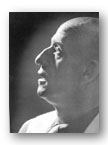 impressive duration, spanning almost half a century of active work— Nelly produced a large number of portraits, most of them created to earn her living. This is not to say that these photographs, and those of people seen by chance on the street, of workers, farmers, beggars and monks, do not meet her usual high technical and aesthetic standards. All these works —from the first, of the pre-War period, to the last, including those of the ‘Figurehead’, the New York studio, and of Dimitris Mitropoulos— are unusually atmospheric and express a painterly disposition in accordance with the spirit of their age. This takes the form of the inclusion of Symbolist elements, of Realistic features, or of a contemporary visual approach.
impressive duration, spanning almost half a century of active work— Nelly produced a large number of portraits, most of them created to earn her living. This is not to say that these photographs, and those of people seen by chance on the street, of workers, farmers, beggars and monks, do not meet her usual high technical and aesthetic standards. All these works —from the first, of the pre-War period, to the last, including those of the ‘Figurehead’, the New York studio, and of Dimitris Mitropoulos— are unusually atmospheric and express a painterly disposition in accordance with the spirit of their age. This takes the form of the inclusion of Symbolist elements, of Realistic features, or of a contemporary visual approach.
Her study of ancient sculpture led Nelly to a series of portraits of statues of the ancient gods and heroes in which the personalities of the figures depicted are powerfully present. Their faces are isolated out in such a way that the camera captures all of their inner world and spirituality. This study also served as the stimulus for a series of contemporary realistic portraits of ordinary people, in which her purpose was to produce a comparative typology of the Greek race and prove, in tangible form, continuation of Hellenism.
Nelly’s travels as photographer to the 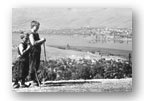 Ministry of Tourism gave her an opportunity to traverse Greece and make a wonderful record of the wildness and beauty of the landscape. Life in the country, and in particular the male and female farming population at work, came to be among Nelly’s most favourite subjects. The characteristic dress of different regions, customs and traditions, and the making of the ‘environmentally-friendly’ products of the time, gave rise to some of Nelly’s finest photographs.
Ministry of Tourism gave her an opportunity to traverse Greece and make a wonderful record of the wildness and beauty of the landscape. Life in the country, and in particular the male and female farming population at work, came to be among Nelly’s most favourite subjects. The characteristic dress of different regions, customs and traditions, and the making of the ‘environmentally-friendly’ products of the time, gave rise to some of Nelly’s finest photographs.
Her wanderings in Greek nature brought Nelly to Mount Athos. She herself was unable to photograph there, since entry to the area is forbidden to women, but
this brought out the photographer in Angelos Seraidaris, an important pianist and her faithful partner in life, whose photographs stand comparison with any others in the archives of Nelly herself and have recently been the subject of separate study and a book.
This unit consists of photographs taken during Nelly’s travels through Greece as part of her collaboration with the Ministry of Tourism in the period down to 1939. It preserves —as artistic and historic documents— a record of the toil of manual labourers and craftsmen (smiths, bell-makers, marble masons) at work on the production of items which are usually manufactured by mechanical means today.
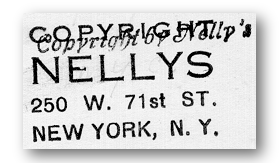
In 1939, the Ministry of Tourism entrusted Nelly with the task of decorating the Greek pavilion at the New York World’s Fair. The outbreak of the Second World War found her in New York —with her husband, the musician Angelos Seraidaris, one of her most valued collaborators. The virtually compulsory exile from Greece which began at this time lasted twenty seven years.
In her new homeland —the fourth, after Asia Minor, Germany and Greece— Nelly began from the beginning again. She soon developed a working relationship
with the Greek community, and with the help of important individuals who recognised her talents (including Eleanor Roosevelt, the photographer Brodovitz, who taught her photojournalism, and Aristotle Onassis) she soon had American clients as well. Her own cosmopolitan behaviour, fluency in foreign languages and general comportment guaranteed her acceptance by the highest reaches of New York society.
With the exception of a series of portraits of outstanding quality, such as that of Dimitris Mitropoulos, most of Nelly’s work in New York consisted of photographs of social events and studio portraits. Although her talent is unmistakable, these photographs lack the intensity and power of her pre-War works. They are little more than a self-satisfied record of life in one of the most fortunate sections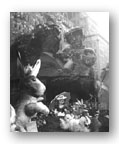 of a prosperous society. However, New York provided Nelly with an opportunity to record some of the key moments in the building of the city and to capture scenes from its streets and squares. Two of her most important series, ‘Easter Parade’ and ‘Streets’, amazed her new teacher and proved that she was not capable only of working to commission: she could also provide a new reading for the architecture and everyday life of the vast city. The
perspective shots, the playful treatment of light, and the originality of composition in ‘Easter Parade’, and the acute angles, contrasts, and diagonal shots intended to optimise the dynamic depiction of a city unique for its architecture in ‘Streets’ make these two series among her finest. Nelly was able to approach these two units in a manner comparable with her best achievements of the pre-War period, producing works equivalent to her depictions of the ballerinas in Germany, the refugees from Asia Minor, and the architectural model of antiquity and making her own statement as to how a new world should be perceived and expressed.
of a prosperous society. However, New York provided Nelly with an opportunity to record some of the key moments in the building of the city and to capture scenes from its streets and squares. Two of her most important series, ‘Easter Parade’ and ‘Streets’, amazed her new teacher and proved that she was not capable only of working to commission: she could also provide a new reading for the architecture and everyday life of the vast city. The
perspective shots, the playful treatment of light, and the originality of composition in ‘Easter Parade’, and the acute angles, contrasts, and diagonal shots intended to optimise the dynamic depiction of a city unique for its architecture in ‘Streets’ make these two series among her finest. Nelly was able to approach these two units in a manner comparable with her best achievements of the pre-War period, producing works equivalent to her depictions of the ballerinas in Germany, the refugees from Asia Minor, and the architectural model of antiquity and making her own statement as to how a new world should be perceived and expressed.
Nelly’s artistic identity seems to confirm the topical value of a question which greatly concerned the art world in her day: is it possible for an artist to be simultaneously classical and modern? Nelly’s modernism can be seen largely as an extrapolation of the nineteenth century, in the sense that although she used techniques and cameras which were then ‘state-of-the-art’ (Duxochrome, Zeiss, Contax, Leica), her art was largely influenced in aesthetic and thematic terms by the artistic trends and the
atmosphere which prevailed in Germany from the end of the 19th century to the First World War.
This is not to say, however, that Nelly 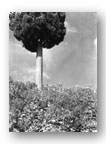 remained anchored in an academicism which had declined into sterility or in an outdated aesthetic. Thanks to her
restless spirit and technological progress, Nelly was able to revolve around an axis in which some of the characteristics of the nineteenth century —those which suited her temperament and her concept of beauty— survived.. Elements such as lyricism (let us not forget that Nelly’s original ambition was to study music and painting), the reference to the civilisations of antiquity, the praise of nature and the re-integration of man into it, found in Nelly not only a sensitive recipient but also a talented artist capable of singling them out as healthy elements and unsurpassed values and of incorporating them, dynamically, into her art.
remained anchored in an academicism which had declined into sterility or in an outdated aesthetic. Thanks to her
restless spirit and technological progress, Nelly was able to revolve around an axis in which some of the characteristics of the nineteenth century —those which suited her temperament and her concept of beauty— survived.. Elements such as lyricism (let us not forget that Nelly’s original ambition was to study music and painting), the reference to the civilisations of antiquity, the praise of nature and the re-integration of man into it, found in Nelly not only a sensitive recipient but also a talented artist capable of singling them out as healthy elements and unsurpassed values and of incorporating them, dynamically, into her art.
It could be argued with justice that ancient Greece was never better expressed in art than in the Germany of the nineteenth century. Echoes of the academic
painting of the Munich School and of the more recent Neue Kunst movement, with its combination of powerful mysticism and a new style, could still be heard in Austria and Germany in the 1920s and appealed strongly to the ideals of the young girl from Asia Minor. Of course, this also applied to Dresden, the city where Nelly lived for five years; as a cosmopolitan and art-lover, she found herself quite close to the new artistic ventures which were already under way in Berlin and Dassau and which were to change the face of art not only in Germany but also throughout the rest of Europe.
Although Nelly’s treatment of most of her subjects is ‘classical’ (with the exception of some of her New York work, which contains many modern elements in the angle of vision and the structure and dynamics of the photograph), she worked with uncommon professional conscientiousness and frequently engaged in experimentation, always producing results of the utmost technical and aesthetic refinement.
Franz Fiedler had believed it was impossible to take colour photographs using the Bromoil method, and indeed the technique was used exclusively in black and white; that, however, did not prevent Nelly from taking three Bromoil nudes in a rare —possibly unique— application of the method.
Nelly soon realised that the structural type of the composition was her own personal responsibility, and this led her to ‘construct’ her image on the basis of a methodology which she herself devised. During printing, she made frequent use of dodging, which enabled her to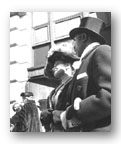 correlate the organic components of the photograph and control it very closely, marking out the boundaries of the subject and by cropping it so as to accentuate the structural type of the composition. Her acceptance of the subjective
element in the image led her to a search for the inwardness of each of her subjects, and she was never afraid even to intervene in the factual aspects of the subject —for example, by transforming the physical bulk of a house in the country into a source of incorporeal light. Her understanding of the role of light in the moulding of form enabled her to assign to it also the role of accentuating the more profound essence of form, an area in which she modelled her work on painting. This was the method by which she created —for example— the superb portrait of Dimitris Mitropoulos, compelling the light to follow a specific course across the subject’s profile. Here, it would seem, Nelly is adhering to the axioms of Moholy-Nagy, who wrote in 1929:
correlate the organic components of the photograph and control it very closely, marking out the boundaries of the subject and by cropping it so as to accentuate the structural type of the composition. Her acceptance of the subjective
element in the image led her to a search for the inwardness of each of her subjects, and she was never afraid even to intervene in the factual aspects of the subject —for example, by transforming the physical bulk of a house in the country into a source of incorporeal light. Her understanding of the role of light in the moulding of form enabled her to assign to it also the role of accentuating the more profound essence of form, an area in which she modelled her work on painting. This was the method by which she created —for example— the superb portrait of Dimitris Mitropoulos, compelling the light to follow a specific course across the subject’s profile. Here, it would seem, Nelly is adhering to the axioms of Moholy-Nagy, who wrote in 1929:
“Although 100 years have passed since the invention of photography, its true discovery is only just beginning. Photography is a brilliant image which ought to correspond to the profound emotion of inner life.”
Knowing that the viewer will identify with her position, Nelly increases his awareness not only in her subject-matter but also by raising questions in his mind. One example of this is the photograph of the ‘Temple of Olympian Zeus’, in which the image can be read in a double manner with regard to the horizon of the ground.
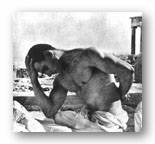
In the Acropolis photographs, Nelly uses specific structural types in the compositions in order to discover the inner geometry of the space. These types may be static, with projection of the relationship between the horizontal arrangement and the perpendicular, may involve the incorporation of a diagonal axis as an element of movement and of the vista, or may amount to a conceptual hierarchy, from the foreground to the background in the planes of the image, with a dialectical relationship between inside and outside achieved by using a ‘window’ in constructing the image.
Much of the Acropolis work is notable for its movement from shadow into light; shadow is the starting-point, an axis of conceptual correlation, and light is a
kind of catharsis. In this way, a movement in physical space becomes a movement in mental space. Nelly often composed using an inductive conceptual system in which the meaning of the next shot or subject is more closely defined by the meaning of its predecessor —and vice versa, as if she were attempting to bring the composition to a
climax in terms not only of resolution but also of definition.
For Nelly, the substantial is the other side of the insubstantial. Thus, the half-clad Nikolska becomes a part of the truth of the column, into whose flutes her shadow blends. Similarly, when she poses her nude athlete in such a way as to remind us of Rodin’s Thinker, she treats him on equal terms with the temple standing behind him.
Nelly is, beyond question, part of an extrapolated neo-Romantic tradition, despite the fact that features from Symbolism and even neo-Realism are often to
be found in her photographs. In every case, what stands out most strikingly is her love of her native land and her attempt not to prettify it but to present it in a way most capable of conveying its timeless character over the passage of the centuries. Almost a hundred years old today, Nelly has succeeded not only in handing down to us a vast oeuvre rich in events, but also in chronologically spanning the twentieth century. Her work itself provides us an answer to the question about classicism and modernity. Nelly is a classical European photographer with avant-garde elements associated with the structural composition of her photographs —leading to the creation of a kind of museι fantastique of the images which she herself wished to preserve.